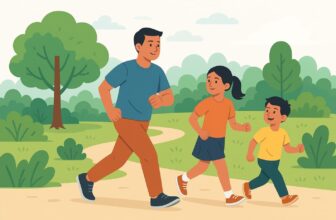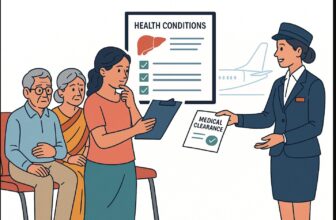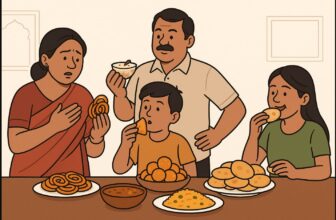The monsoon brings welcome relief from summer heat, but also an invisible wave of bacteria, viruses, and parasites. If you’ve ever fallen sick during this season, you know how fast a minor fever or stomach ache can turn into days of weakness, dehydration, or worse.
Every year in India, monsoon triggers a rise in waterborne and mosquito-driven illnesses. Yet many of them are avoidable if you understand their early signs and environmental triggers.
Whether you live in a city or a small town, monsoon brings a real health challenge. The air is damp, the roads are waterlogged, and hygiene takes a hit. That’s when bacteria, viruses, and fungi thrive, and so do diseases.
This list will help you stay one step ahead. You’ll learn:
- Which monsoon illnesses are most common
- How to spot their early symptoms
- What they’re called in Hindi
- And how to protect yourself and your family
Why You’re More Likely to Fall Ill During Monsoon
Humidity and waterlogging don’t just inconvenience your daily commute, they change how disease spreads in your environment:
- Stagnant water creates breeding grounds for mosquitoes
- Contaminated drinking water leads to stomach and liver infections
- Constant dampness makes your skin more prone to fungal overgrowth
- Shared spaces and low immunity mean even mild viruses spread faster indoors
The result? A unique spike in illnesses that don’t affect you the same way in summer or winter.
13 Diseases That Become More Common (and Risky) During Monsoon in India
Each disease below includes:
- How you get it
- Early symptoms you can catch
- Why it becomes dangerous if ignored
- What you can do to protect yourself
1. Dengue
Spread by: Aedes mosquitoes that bite during the day
Starts with: Sudden high fever, muscle pain, eye pain, and red rashes
Why it escalates: Platelet count drops quickly, risking internal bleeding
What helps: Use repellents even indoors, dry out water in coolers and flowerpots, wear full-sleeve clothes, even in your balcony
2. Malaria
Spread by: Anopheles mosquitoes breeding in dirty, still water
Initial signs: Fever in cycles (every 2–3 days), chills, sweating, vomiting
What’s dangerous: If untreated, it can damage the liver and blood cells
Precaution: Use nets at night, clean rooftop water tanks, and take symptoms seriously, don’t self-medicate
3. Chikungunya
Mosquito-borne like dengue, but with different after-effects
Clues: Debilitating joint pain, rash, low-grade fever, fatigue
Real issue: Joint stiffness can last for months even after fever goes
Prevention tip: Mosquitoes that spread chikungunya bite most during early morning and sunset, don’t leave windows open then
4. Leptospirosis
Catch it from: Wading through floodwater that contains rat urine
Warning signs: Muscle pain, eye redness, headache, vomiting
What it turns into: Kidney failure or meningitis if it goes untreated
Avoid it: Don’t walk barefoot in flooded areas, wash feet thoroughly if exposed, wear covered shoes in wet areas
5. Typhoid
Water and food-borne through unclean utensils or untreated water
How it shows up: Persistent fever, body weakness, stomach pain, and poor appetite
How it worsens: If ignored, it affects intestines and energy levels for weeks
What helps: Say no to roadside cold drinks, always eat hot, fresh food, and consider getting vaccinated
6. Hepatitis A
Spreads via: Contaminated water, especially in homes with poor drainage
First signs: Yellowing of skin and eyes, dark urine, nausea, low-grade fever
What makes it serious: The virus inflames your liver and slows recovery for weeks
Prevent it: Boil your drinking water during monsoon, even if you use filters
7. Gastroenteritis
What causes it: Viruses or bacteria from unhygienic food
What it feels like: Sudden diarrhoea, nausea, stomach cramps
Why it’s risky: Children and elders get dehydrated very fast
Best action: Rehydrate with ORS, avoid milk-heavy or spicy food, stick to khichdi or curd rice until stable
8. Cholera
Rare but deadly: Spread via unclean water or street food
Watch for: Massive watery diarrhoea and weakness within hours
It turns fatal: If you lose too much fluid before treatment
Your shield: ORS sachets at home, say no to roadside chutneys and golgappa water, and check if your area has alerts
9. Seasonal Flu
Triggered by: Temperature swings and indoor crowding
What shows first: Body ache, fever, cough, runny nose
Where it goes wrong: Turns into bronchitis or secondary infection in weak lungs
Stay protected: Don’t share towels or phones, open your windows for 10 minutes daily even during rain
10. Ringworm, Athlete’s Foot, and Other Fungal Infections
Flare up from: Moist clothes, wet socks, damp skin folds
What to spot: Itchy circular red patches, peeling feet, groin rashes
What’s frustrating: It keeps coming back unless fully treated
Monsoon fix: Use antifungal powder after showers, change socks twice a day, don’t wear tight jeans if they’ve been soaked
11. Scabies
Spread through: Skin contact or shared bedding during humid conditions
Symptoms: Intense itching (especially at night), tiny blisters between fingers
Where it worsens: It spreads to the whole household fast
Stop the spread: Hot wash all clothes and bedsheets, keep fingernails short, treat every close contact, not just the one itching
12. Conjunctivitis
Spreads like wildfire: Especially in schools or offices
Starts with: Red, watery, burning eyes and sticky discharge
Don’t ignore: If pain increases or vision gets blurred
Your role: Don’t touch your eyes after touching doorknobs, wash pillow covers daily, avoid eye makeup
13. Jaundice
Linked to: Waterborne Hepatitis E virus
Symptoms: Yellow eyes, fatigue, no appetite, bitter taste in mouth
Danger point: The liver gets inflamed and takes time to recover fully
Stay protected: No raw food from outside, skip cold chaats and street drinks during this season, use boiled water even for brushing
What You Can Do Daily to Avoid Getting Sick
For your body:
- Start your day with warm water + lemon or tulsi
- Dry yourself thoroughly, especially feet and underarms
- Wear cotton, avoid wearing damp clothes for long
For your home:
- Dry bathroom floors quickly
- Don’t use carpets or jute mats that hold moisture
- Run a fan even during rain to reduce indoor humidity
For your kitchen:
- Boil milk and drinking water daily
- Wash vegetables thoroughly, even if they “look clean”
- Avoid pre-cut fruit or packaged chutneys
Know When It’s Time to See a Doctor
You don’t need to panic at the first sneeze, but don’t wait too long either. Seek medical help if:
- Fever lasts more than 2 days
- Diarrhoea doesn’t stop after rehydration
- Eyes turn yellow
- Rashes spread or worsen
- Pain moves to joints, eyes, or chest
Delays can turn a treatable condition into a long recovery.
Summary: Monsoon Isn’t Just Rain, It’s the Start of Health Risks
Monsoon doesn’t have to mean illness. With the right awareness and early response, you can avoid the cycle of fever, weakness, missed work, and prescriptions. Protect yourself without fear, just with attention.
Stay alert, stay clean, and make small daily choices that keep you safe. A little prevention today can save a lot of trouble tomorrow.





